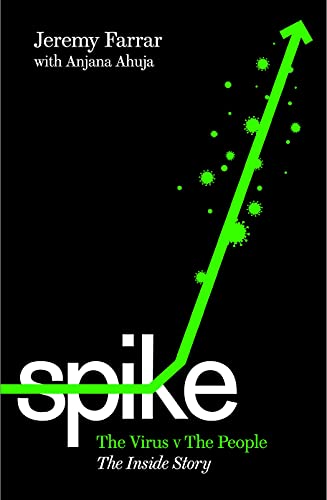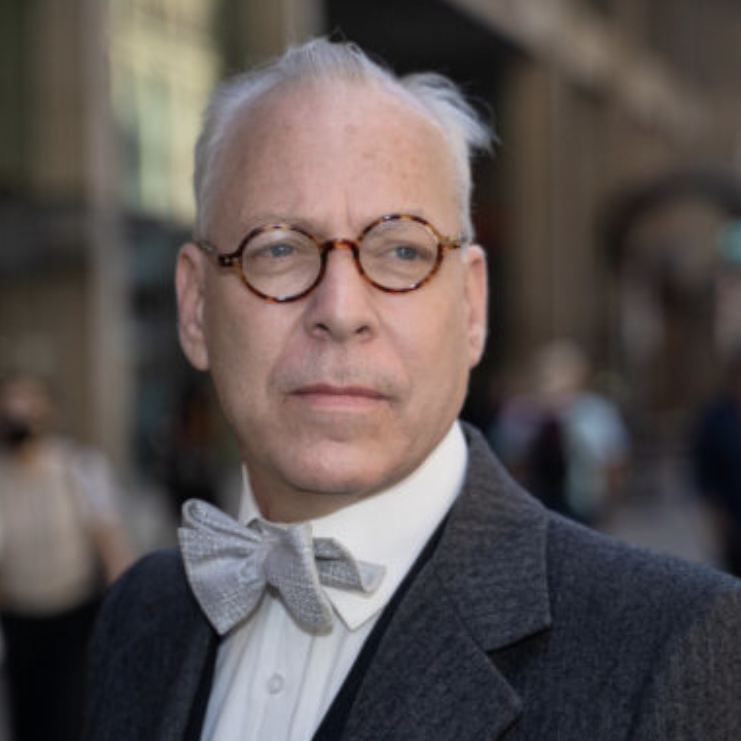I’ve heard the following question seemingly thousands of times over the last year: “Why did they do this to us?”
It’s still the burning question about lockdowns: the school, business, and church closures, the banning of events, the stay-at-home orders, the travel restrictions, the wildly desperate central plan enforced by the police somehow to keep people apart from each other. The failure to control or even mitigate pathogenic trajectory – even forgetting about the astonishing social costs – is by now indisputably obvious, at least to some of us.
What precisely was the intention of lockdowns?

To answer this question, I turned to the book Spike, by Jeremy Farrar (with Anjana Ahuja). He is not a well-known figure in the US, but in the UK he is basically their own Dr. Fauci. He wields huge institutional influence, through the Wellcome Trust, controlling both opinion within the epidemiological profession and funding resources for research. He was probably the dominant influence for enacting lockdowns in the UK, more so than Imperial College’s Neil Ferguson.
The book is a tell-all, day by day from the time of the dawning of awareness of the pathogen throughout the year. The book strikes me as forthcoming, and all the more terrifying for it. It reveals much about his friends, associates, frustrations, debates, strategies, worries, internal drama, and intellectual orientation, which is overwhelming in favor of deploying massive state power to control the invisible enemy.
I’m a very polite writer, but I cannot decline to admit my complete alarm at so deeply encountering the mind of a person who did what he did and thinks what he thinks. Once he became completely convinced of lockdownism, he went all in. “Social distancing measures should be mandatory, not optional,” he writes. “A prime minister cannot ask people to lock down if they feel like it….that is not the way these sorts of public health measures work.”
Those little bromides – this casual dismissing of all concerns that might have doubts about a medically informed totalitarian state – are strewn throughout. I personally cannot fathom the psyche of a person who imagines that his profession entitles him to control all human interactions by police force, with gendarmes prohibiting people from behaving completely normally, and using violence against them for daring to engage with each other, opening their schools and businesses, and otherwise going about their lives peacefully – and genuinely believing that this is the best thing for society all told.
I truly cannot fathom that. Few people can.
As to the driving question of why, oddly I finished this book without a consistent and clear answer. His thinking on the topic of lockdowns and their objective migrates from chapter to chapter. There is no clear objective other than to do something dramatic as a display of government power and willingness to act. He nowhere admits failure, of course, and predictably explains away all problems with the claim that governments should have locked down more things at a much earlier date. All problems in his view trace to not having institutioning his personal version of the totalitarian state earlier than was politically feasible. If you read this book, just keep this in mind: we are talking about a mental framework that would in any context otherwise be considered psychopathic.
Maybe the purpose of lockdowns was to save hospital space but that turned out to be nearly a non-problem in the US. Maybe it was to buy time to put track and trace in place, but track and trace to what end? Suppress the virus? Maybe, and maybe that was the point of lockdowns, to keep people apart so that the virus would not spread. But that raises the profound question: after this (and when is after and how can you know?) where does the virus go? And when you open up, presuming that this works (which is still not clear) doesn’t it just start spreading again? What then? Just how flat and for how long must this curve be?
Even after reading this book, I wish I could answer even one of those questions. After all this time, it is still unclear what in the world the people who locked down society were actually thinking. The Farrar book gives some insights – it was all about their bloody models! – but that’s about all we know. What was the end game, the exit strategy, and whence came their astonishing confidence that something never before tried on this scale possibly could work to deal with viral infection that is ultimately a matter of individual health? He makes mild efforts to bolster his theory but they are unsatisfying.
“Deciding to close an economy is unbelievably tough,” he concedes. “Other than during wars, Western economies had never had a lockdown since the Middle Ages, to my knowledge; this is just not something governments do.” Still, it had to be done. Just look at how well it worked in China and look at what was going on in Europe! You want freedom given this? You are crazy. Let’s use modern methods of modeling to show to what extent and how people need to be muscled to fix the problem.
Despite political resistance, and in the midst of media and popular panic, his views prevailed in the course of many battles. He was thrilled at the first imposition of lockdowns in the UK.
“The new restrictions meant people would be unable to leave home except for one of four reasons: to travel to and from work if work could not be done from home; to exercise once a day; to buy food and medicines; and to seek medical care. Shops selling non-essential goods would shut and gatherings of more than two people who did not live together would be banned. People were warned to keep two metres away from people they did not live with. Weddings, parties, religious services would stop, but funerals could still go ahead. SAGE, like so many other working groups around the world, switched to using Zoom.”
How precisely lockdowns fix anything is never clear. Consider that when the US and the UK were locking down, vaccines were not really on the horizon. Fauci himself said they would never be necessary. Farrar reveals that he never believed that lockdowns alone would really work, and claims now to believe that the whole purpose was just to wait for a vaccine.
“Lockdowns alone cannot get a society back to normality: as I never tire of saying, they do not change the fundamentals of a virus or a pandemic. Staying indoors does not alter a pathogen’s transmissibility or ability to wreak harm; it just takes susceptible people out of circulation. When a lockdown ends, those people go back into circulation again. Without a vaccine or other measures in place, untying restrictions increases social contacts and transmissions rise. If restrictions eased and R shot up to 3 again, we would find ourselves back at square one, with an epidemic racing exponentially out of control as it did in late March 2020. Science – vaccines, drugs, testing – was the only exit strategy.”
Did you ever really believe that it was two weeks to flatten the curve? The people who pushed lockdowns on governments around the world did not believe that. It was marketing and nothing more. For Farrar, lockdown is a more infallible doctrine than a testable strategy of viable disease mitigation. For him, lockdowns are really just a way for governments to do something in the face of a pandemic.
“For the record, nobody is pro-lockdown,” he assures us. “Lockdowns are a last resort, a sign of failure to control the epidemic in other ways. Locking down does not change the fundamentals of a virus,” he acknowledges, “but buys time to increase hospital capacity, testing, contact tracing, vaccines and therapeutics.” Which is to say that if you have capacity, tracing, and medicine, lockdown is not necessary? You would not believe that from the rest of the book that treats lockdowns as a panacea, the only real and glorious path for any society under any threat from a new pathogen.
As for vaccines, even our author admits that they didn’t do the trick either, granting “vaccines might not work quite as well as anticipated. At worst, they might not work at all.” This of course is due to mutations. So we are back to square one, lockdowns forever without end due to the natural evolution of pathogens of the sort we evolved over millions of years to live with in a dangerous dance that we once sought to understand rather than fly into wild panic and abolish social interaction itself.
In one of the most bizzare passages in the book, among many, is his theory that blames natural immunity on mutations, as if exposure itself is always a problem. “The virus encountered survivors with some natural immunity,” he writes, “This put added pressure on the virus to evolve, resulting in the variants.” Wow. But he means it, pointing to zero-Covid nations like New Zealand who have fewer troubles with variants. Here is where the author tips his hand completely: his whole outlook is that the entire world must be scrubbed free of bugs, even if it means a complete dismantling of civilization.
Who could object? Many people, and the author purports to understand this. “We cannot begin to comprehend the anguish of a leader who is deciding whether to shut down his or her country,” he says, “but the later the action, the more lives that will be lost and the more disruption to all sectors of society: schools, businesses, leisure, transport. Governments are eventually forced to act because they cannot simply stand by and watch their health systems collapse.”
This language that governments are “forced” to act. How so? They have never been so forced before. What was different about 2020 as versus 2013, 2009, 1968, 1957, 1942, 1929, and so on. It can’t be severity as such: we are still waiting on data to confirm that relative to pandemics past, plus there is no one measure of severity as such; it depends on the place and the demographic and immunological map. Lockdowns pertain to everyone everywhere regardless. No, this was about implementing an experiment based on modelling. Governments were “forced” to follow the advice of the architects.
Also, you can see from the above passage that we are again back to health care systems. It’s always the fallback for these people. The medical system cannot scale so we have to shut down society! It’s all very strange. Let’s say you have a choice. You can build field hospitals, recruit volunteers, order more supplies, and push through the rough patches depending on need (which cannot be known in advance) or you can smash the human rights and freedoms of hundreds of millions of people for an unlimited period of time. Which is the better option? For these people, the answer was obvious. They wanted to conduct their experiment.
Still later in the book, he offers a different if more honest view of the purpose of lockdowns: to prevent “the quantity of virus to rise in a population.” Boom. So that’s it. He wants to make not peace but war. He openly admits it: “elimination – banishing the virus from countries or regions through control measures – is possible and indeed desirable.”
Sorry, but this is futile and deeply dangerous, even with great vaccines that strike down every conceivable variant. This path would condemn a substantial portion of the world’s population to a permanent state of immunological naivete, and introduce the single biggest and most deadly threat we could ever face, potentially more of a killer than nuclear war. Think of all the native peoples in the US who died of smallpox after Westerns brought the pathogen with them. At least 30% of the population died in the first round of death, and another third later. The reason was the absence of an immunological wall – and it strikes me that Farrar would risk repeating the disaster with his push for zero exposure.
Is this what lockdowns attempted? In part, yes, though we were not told that at the time. In any case, the lockdown experiment did not work to control the world of pathogens but did profound damage to social and market functioning. The virus still did its thing. I believe the author knows this, which is why he cannot bring himself honestly to engage in serious evaluation. “Lockdowns are a sign of big government and undoubtedly curb individual freedoms in a draconian way that none of us want,” he says in passing. “But the alternative is worse, as we have discovered.” Sorry but that just doesn’t do as an argument. You can’t just claim “it would have been worse” and expect all recrimination to go away.
Another tactic the author deploys is to mischaracterize and even demonize anyone with whom he disagrees. This is precisely how he treats the authors of the Great Barrington Declaration. In what are perhaps the most egregious few pages in the book, he trashes this perfectly sane and normal statement of basic cell biology and public health as ”ideology masquerading as science,” “nonsense,” “lacks credibility,” “no data,” “done a great disservice to science and public health,” and “responsible for a number of unnecessary deaths.”
There are just far too many eggs in this pudding. If he has one complaint against the actual text, I would like to see it. He doesn’t even bother quoting it, which is very telling. But to accuse people who took great professional risks to reveal untold truths of killing people is next-level stuff. This kind of rhetoric should be inadmissible in scientific discourse. The whole section tipped me off to the underlying reality of this book: it is a primal scream not to pay any attention to those who warned against lockdowns.
Vinay Prasad correctly writes: “When the history books are written about the use of non-pharmacologic measures during this pandemic, we will look as pre-historic and barbaric and tribal as our ancestors during the plagues of the middle ages.” Farrar’s book is designed to forestall the inevitable discrediting of both his ideas and policies.
At some level, I’m not among those who doubts the sincerity of the people like this author. I do believe that they believed their plans would somehow work to achieve a vaguely defined objective, namely to minimize the social impact of a pandemic of a new virus. As Lord Sumption writes: “There are few more obsessive fanatics than the technocrat who is convinced that he is reordering an imperfect world for its own good.”
For a good part of the 20th century, public health deployed a well-worked-out strategy for reducing harm in a pandemic, and this approach served society very well during a century when lives lengthened and pathogens vexed humanity ever less than in history. That solution is for vulnerable populations to protect themselves, for the sick to have access to therapeutics, and for social functioning to continue in calm while herd immunity builds among the non-vulnerable. That sounds more boring than draconian lockdowns but in this case boring is good: it is what is consistent with rationality and experience.
Another way to read this book is to imagine that it is not about a virus but rather a rising ocean tide, a rising sun, or the change of seasons. Just imagine the head of a scientific and governmental team that sets out on a major project not to deal with reality based on experience but rather to prevent one of these events via massive coercion of the human population. It would be quite a tale of models, politics, intrigue, frustration, and anguish, with the ins and outs of many sectors on which to report, from internal discussions to press relations to inter-agency squabbles, all of which results in what was going to happen anyway. Such a book would be a farce. Such will be the fate of many of these autobiographical tell-alls from the architects of the lockdowns that wreck so much about life on earth last year and this.
This book ends with a predictable note of panic and an apocalyptic prediction of a much worse germ that arrives to eat us all. How do we prevent that? By putting him in charge: “We must plan for the worst. We know what we need to do. In the perpetual battle of the virus versus the people, we have the knowledge and power to bring about a just and fair outcome.”
In the sweep of history, intellectuals have specialized in conjuring rationales for why freedom needs to be ended in favor of top-state statist forms of social planning. There were religious reasons, genetic reasons, end-of-history reasons, security reasons, and a hundred more.
Every age has generated some fashionable and overriding reason why people cannot be free. Public health is the reason of the moment. In this author’s telling, everything we think we know about the social and political order must conform to his number one priority of pathogen avoidance and suppression, while every other concern (such as freedom itself) should take a back seat.
Reading this book, then, is a strange encounter with a new ideology and a new statist vision, one that poses a fundamental threat as disorienting and confusing as a new virus. Unbeknownst to most of us, lockdownism as an ideology, as a replacement for traditional law and liberty, had been growing and consolidating its influence for at least a decade and a half before it was deployed on the world in the shock and awe of 2020. Defenders of freedom need to know if they do not know already: here is another enemy, and its defeat will only come with honest and precise intellectual engagement.
In some ways, Farrar’s manifesto is a good beginning to get to know the mindset that threatens everything we love.
Join the conversation:

Published under a Creative Commons Attribution 4.0 International License
For reprints, please set the canonical link back to the original Brownstone Institute Article and Author.









